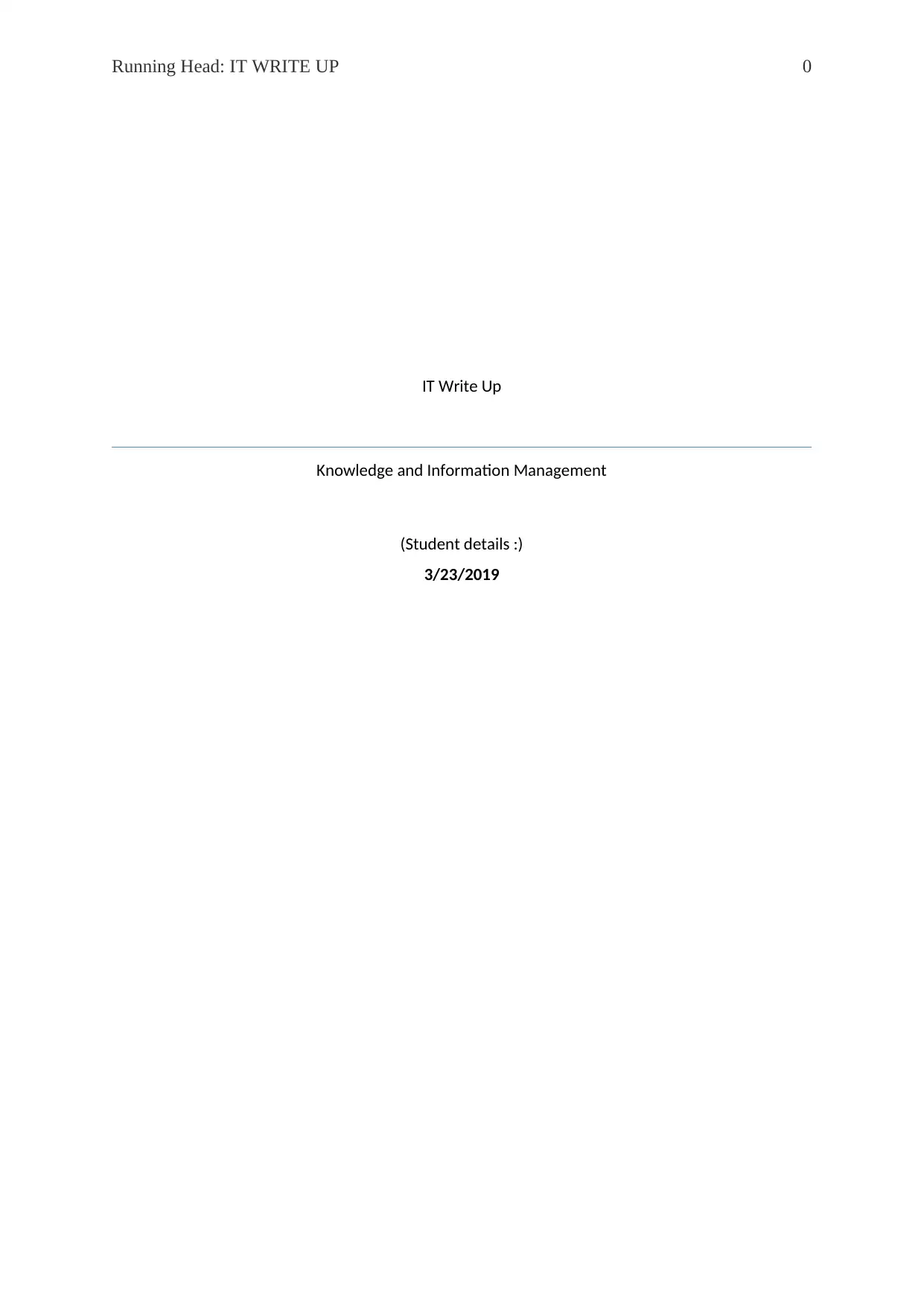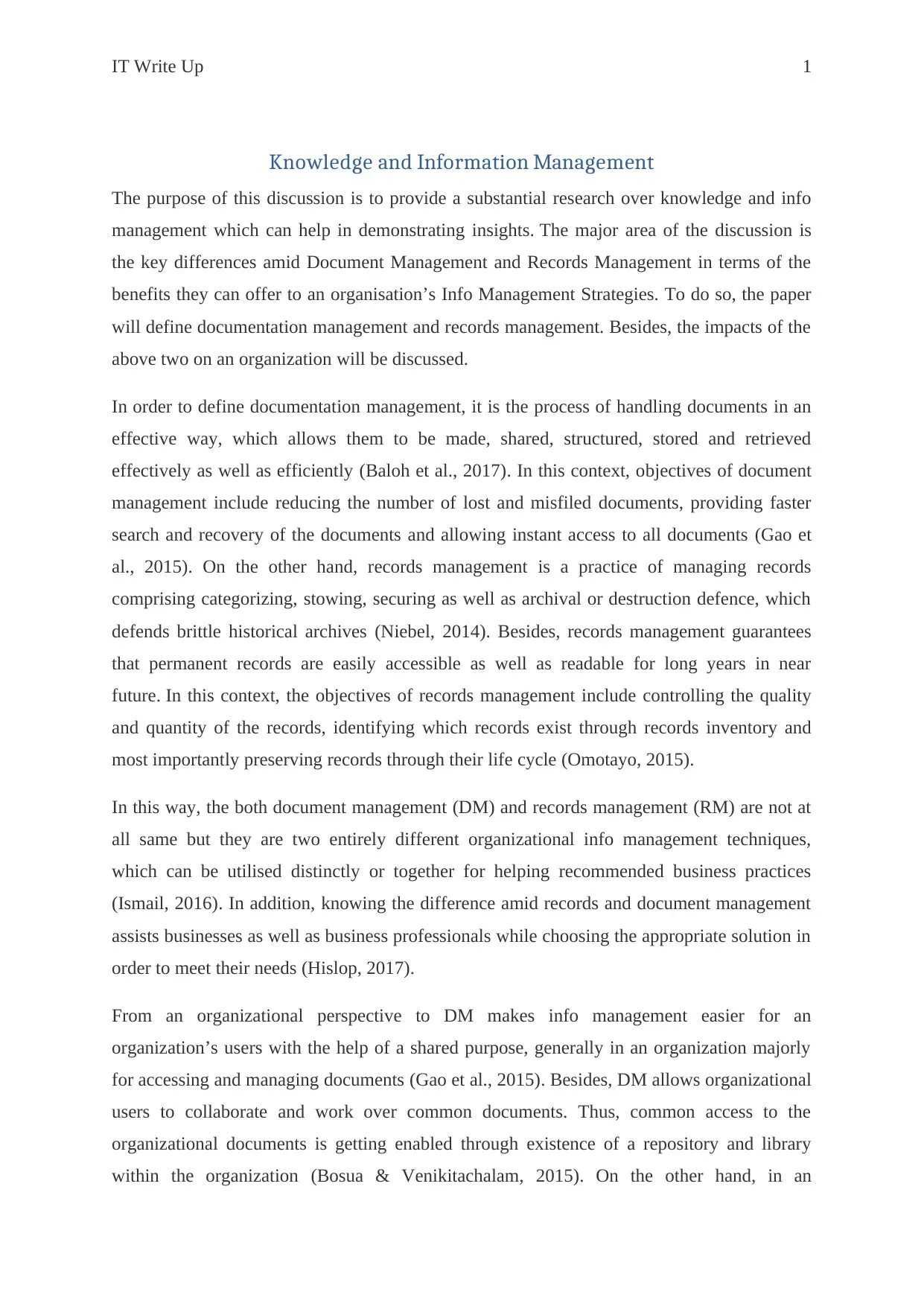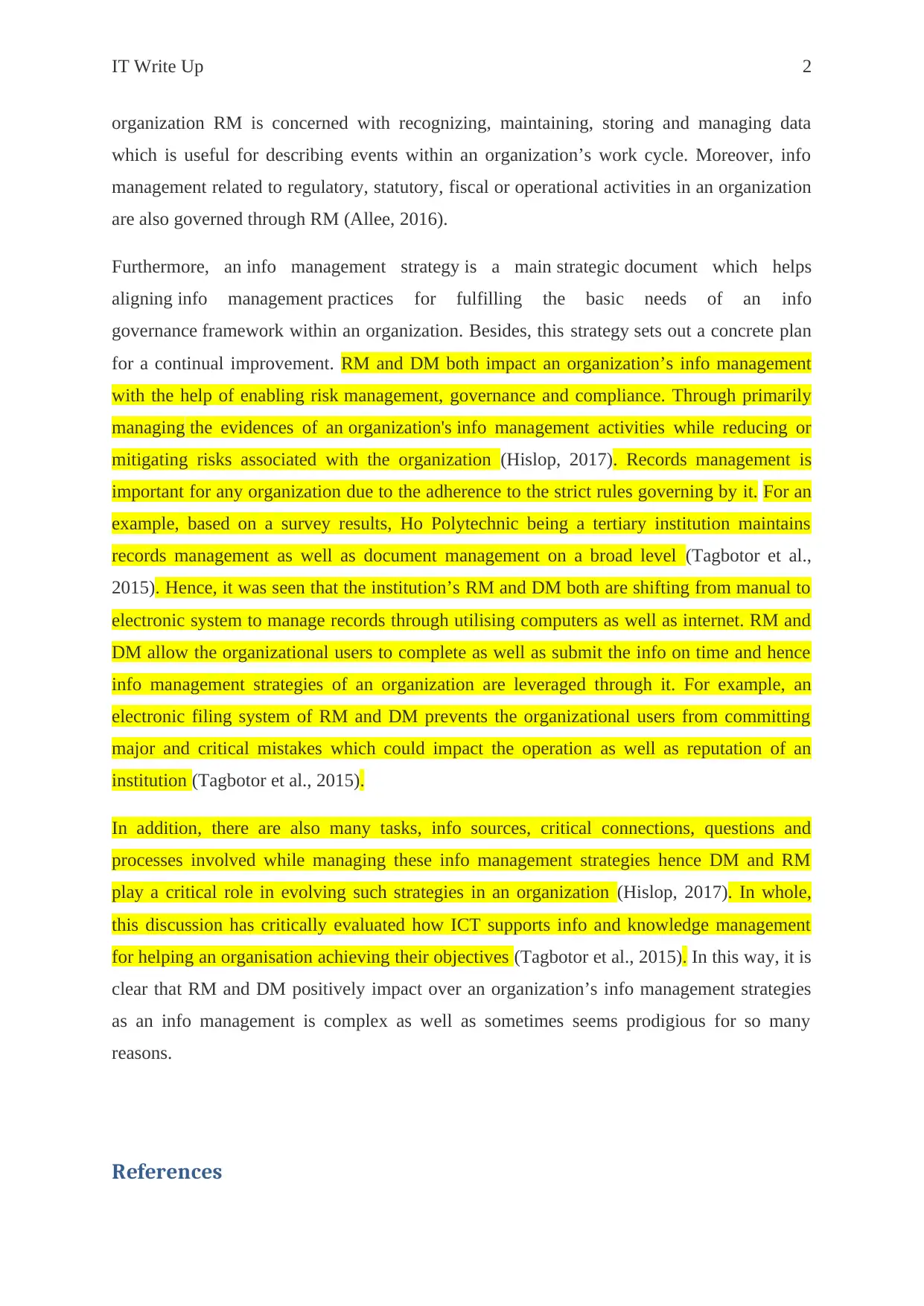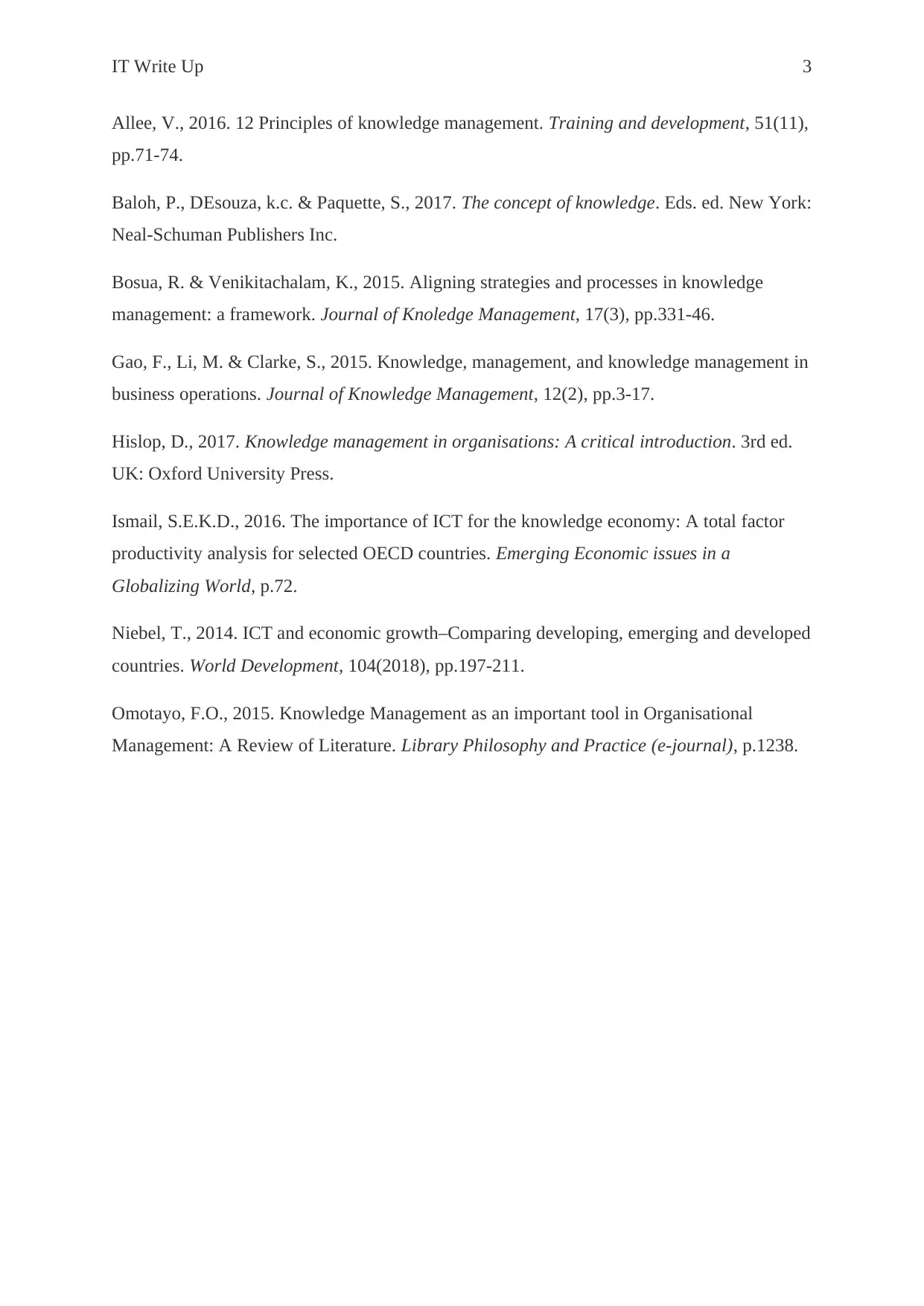IT Write Up: Knowledge and Information Management Strategies Review
VerifiedAdded on 2023/04/11
|4
|936
|174
Report
AI Summary
This report delves into the critical distinctions between Document Management (DM) and Records Management (RM), highlighting their individual roles and combined impact on an organization's information management strategies. The report begins by defining both DM and RM, outlining their respective objectives and functions. It then explores how these two practices differ, emphasizing the benefits each offers in terms of efficient document handling, secure record-keeping, and improved information access. Furthermore, the report examines how both DM and RM influence an organization's overall information management strategy, including risk management, governance, and compliance. The discussion also includes an analysis of how ICT supports information and knowledge management to help an organization achieve its objectives. The report concludes by emphasizing the importance of understanding these differences to make informed decisions when choosing solutions to meet specific organizational needs.

Running Head: IT WRITE UP 0
IT Write Up
Knowledge and Information Management
(Student details :)
3/23/2019
IT Write Up
Knowledge and Information Management
(Student details :)
3/23/2019
Paraphrase This Document
Need a fresh take? Get an instant paraphrase of this document with our AI Paraphraser

IT Write Up 1
Knowledge and Information Management
The purpose of this discussion is to provide a substantial research over knowledge and info
management which can help in demonstrating insights. The major area of the discussion is
the key differences amid Document Management and Records Management in terms of the
benefits they can offer to an organisation’s Info Management Strategies. To do so, the paper
will define documentation management and records management. Besides, the impacts of the
above two on an organization will be discussed.
In order to define documentation management, it is the process of handling documents in an
effective way, which allows them to be made, shared, structured, stored and retrieved
effectively as well as efficiently (Baloh et al., 2017). In this context, objectives of document
management include reducing the number of lost and misfiled documents, providing faster
search and recovery of the documents and allowing instant access to all documents (Gao et
al., 2015). On the other hand, records management is a practice of managing records
comprising categorizing, stowing, securing as well as archival or destruction defence, which
defends brittle historical archives (Niebel, 2014). Besides, records management guarantees
that permanent records are easily accessible as well as readable for long years in near
future. In this context, the objectives of records management include controlling the quality
and quantity of the records, identifying which records exist through records inventory and
most importantly preserving records through their life cycle (Omotayo, 2015).
In this way, the both document management (DM) and records management (RM) are not at
all same but they are two entirely different organizational info management techniques,
which can be utilised distinctly or together for helping recommended business practices
(Ismail, 2016). In addition, knowing the difference amid records and document management
assists businesses as well as business professionals while choosing the appropriate solution in
order to meet their needs (Hislop, 2017).
From an organizational perspective to DM makes info management easier for an
organization’s users with the help of a shared purpose, generally in an organization majorly
for accessing and managing documents (Gao et al., 2015). Besides, DM allows organizational
users to collaborate and work over common documents. Thus, common access to the
organizational documents is getting enabled through existence of a repository and library
within the organization (Bosua & Venikitachalam, 2015). On the other hand, in an
Knowledge and Information Management
The purpose of this discussion is to provide a substantial research over knowledge and info
management which can help in demonstrating insights. The major area of the discussion is
the key differences amid Document Management and Records Management in terms of the
benefits they can offer to an organisation’s Info Management Strategies. To do so, the paper
will define documentation management and records management. Besides, the impacts of the
above two on an organization will be discussed.
In order to define documentation management, it is the process of handling documents in an
effective way, which allows them to be made, shared, structured, stored and retrieved
effectively as well as efficiently (Baloh et al., 2017). In this context, objectives of document
management include reducing the number of lost and misfiled documents, providing faster
search and recovery of the documents and allowing instant access to all documents (Gao et
al., 2015). On the other hand, records management is a practice of managing records
comprising categorizing, stowing, securing as well as archival or destruction defence, which
defends brittle historical archives (Niebel, 2014). Besides, records management guarantees
that permanent records are easily accessible as well as readable for long years in near
future. In this context, the objectives of records management include controlling the quality
and quantity of the records, identifying which records exist through records inventory and
most importantly preserving records through their life cycle (Omotayo, 2015).
In this way, the both document management (DM) and records management (RM) are not at
all same but they are two entirely different organizational info management techniques,
which can be utilised distinctly or together for helping recommended business practices
(Ismail, 2016). In addition, knowing the difference amid records and document management
assists businesses as well as business professionals while choosing the appropriate solution in
order to meet their needs (Hislop, 2017).
From an organizational perspective to DM makes info management easier for an
organization’s users with the help of a shared purpose, generally in an organization majorly
for accessing and managing documents (Gao et al., 2015). Besides, DM allows organizational
users to collaborate and work over common documents. Thus, common access to the
organizational documents is getting enabled through existence of a repository and library
within the organization (Bosua & Venikitachalam, 2015). On the other hand, in an

IT Write Up 2
organization RM is concerned with recognizing, maintaining, storing and managing data
which is useful for describing events within an organization’s work cycle. Moreover, info
management related to regulatory, statutory, fiscal or operational activities in an organization
are also governed through RM (Allee, 2016).
Furthermore, an info management strategy is a main strategic document which helps
aligning info management practices for fulfilling the basic needs of an info
governance framework within an organization. Besides, this strategy sets out a concrete plan
for a continual improvement. RM and DM both impact an organization’s info management
with the help of enabling risk management, governance and compliance. Through primarily
managing the evidences of an organization's info management activities while reducing or
mitigating risks associated with the organization (Hislop, 2017). Records management is
important for any organization due to the adherence to the strict rules governing by it. For an
example, based on a survey results, Ho Polytechnic being a tertiary institution maintains
records management as well as document management on a broad level (Tagbotor et al.,
2015). Hence, it was seen that the institution’s RM and DM both are shifting from manual to
electronic system to manage records through utilising computers as well as internet. RM and
DM allow the organizational users to complete as well as submit the info on time and hence
info management strategies of an organization are leveraged through it. For example, an
electronic filing system of RM and DM prevents the organizational users from committing
major and critical mistakes which could impact the operation as well as reputation of an
institution (Tagbotor et al., 2015).
In addition, there are also many tasks, info sources, critical connections, questions and
processes involved while managing these info management strategies hence DM and RM
play a critical role in evolving such strategies in an organization (Hislop, 2017). In whole,
this discussion has critically evaluated how ICT supports info and knowledge management
for helping an organisation achieving their objectives (Tagbotor et al., 2015). In this way, it is
clear that RM and DM positively impact over an organization’s info management strategies
as an info management is complex as well as sometimes seems prodigious for so many
reasons.
References
organization RM is concerned with recognizing, maintaining, storing and managing data
which is useful for describing events within an organization’s work cycle. Moreover, info
management related to regulatory, statutory, fiscal or operational activities in an organization
are also governed through RM (Allee, 2016).
Furthermore, an info management strategy is a main strategic document which helps
aligning info management practices for fulfilling the basic needs of an info
governance framework within an organization. Besides, this strategy sets out a concrete plan
for a continual improvement. RM and DM both impact an organization’s info management
with the help of enabling risk management, governance and compliance. Through primarily
managing the evidences of an organization's info management activities while reducing or
mitigating risks associated with the organization (Hislop, 2017). Records management is
important for any organization due to the adherence to the strict rules governing by it. For an
example, based on a survey results, Ho Polytechnic being a tertiary institution maintains
records management as well as document management on a broad level (Tagbotor et al.,
2015). Hence, it was seen that the institution’s RM and DM both are shifting from manual to
electronic system to manage records through utilising computers as well as internet. RM and
DM allow the organizational users to complete as well as submit the info on time and hence
info management strategies of an organization are leveraged through it. For example, an
electronic filing system of RM and DM prevents the organizational users from committing
major and critical mistakes which could impact the operation as well as reputation of an
institution (Tagbotor et al., 2015).
In addition, there are also many tasks, info sources, critical connections, questions and
processes involved while managing these info management strategies hence DM and RM
play a critical role in evolving such strategies in an organization (Hislop, 2017). In whole,
this discussion has critically evaluated how ICT supports info and knowledge management
for helping an organisation achieving their objectives (Tagbotor et al., 2015). In this way, it is
clear that RM and DM positively impact over an organization’s info management strategies
as an info management is complex as well as sometimes seems prodigious for so many
reasons.
References
⊘ This is a preview!⊘
Do you want full access?
Subscribe today to unlock all pages.

Trusted by 1+ million students worldwide

IT Write Up 3
Allee, V., 2016. 12 Principles of knowledge management. Training and development, 51(11),
pp.71-74.
Baloh, P., DEsouza, k.c. & Paquette, S., 2017. The concept of knowledge. Eds. ed. New York:
Neal-Schuman Publishers Inc.
Bosua, R. & Venikitachalam, K., 2015. Aligning strategies and processes in knowledge
management: a framework. Journal of Knoledge Management, 17(3), pp.331-46.
Gao, F., Li, M. & Clarke, S., 2015. Knowledge, management, and knowledge management in
business operations. Journal of Knowledge Management, 12(2), pp.3-17.
Hislop, D., 2017. Knowledge management in organisations: A critical introduction. 3rd ed.
UK: Oxford University Press.
Ismail, S.E.K.D., 2016. The importance of ICT for the knowledge economy: A total factor
productivity analysis for selected OECD countries. Emerging Economic issues in a
Globalizing World, p.72.
Niebel, T., 2014. ICT and economic growth–Comparing developing, emerging and developed
countries. World Development, 104(2018), pp.197-211.
Omotayo, F.O., 2015. Knowledge Management as an important tool in Organisational
Management: A Review of Literature. Library Philosophy and Practice (e-journal), p.1238.
Allee, V., 2016. 12 Principles of knowledge management. Training and development, 51(11),
pp.71-74.
Baloh, P., DEsouza, k.c. & Paquette, S., 2017. The concept of knowledge. Eds. ed. New York:
Neal-Schuman Publishers Inc.
Bosua, R. & Venikitachalam, K., 2015. Aligning strategies and processes in knowledge
management: a framework. Journal of Knoledge Management, 17(3), pp.331-46.
Gao, F., Li, M. & Clarke, S., 2015. Knowledge, management, and knowledge management in
business operations. Journal of Knowledge Management, 12(2), pp.3-17.
Hislop, D., 2017. Knowledge management in organisations: A critical introduction. 3rd ed.
UK: Oxford University Press.
Ismail, S.E.K.D., 2016. The importance of ICT for the knowledge economy: A total factor
productivity analysis for selected OECD countries. Emerging Economic issues in a
Globalizing World, p.72.
Niebel, T., 2014. ICT and economic growth–Comparing developing, emerging and developed
countries. World Development, 104(2018), pp.197-211.
Omotayo, F.O., 2015. Knowledge Management as an important tool in Organisational
Management: A Review of Literature. Library Philosophy and Practice (e-journal), p.1238.
1 out of 4
Related Documents
Your All-in-One AI-Powered Toolkit for Academic Success.
+13062052269
info@desklib.com
Available 24*7 on WhatsApp / Email
![[object Object]](/_next/static/media/star-bottom.7253800d.svg)
Unlock your academic potential
Copyright © 2020–2025 A2Z Services. All Rights Reserved. Developed and managed by ZUCOL.





